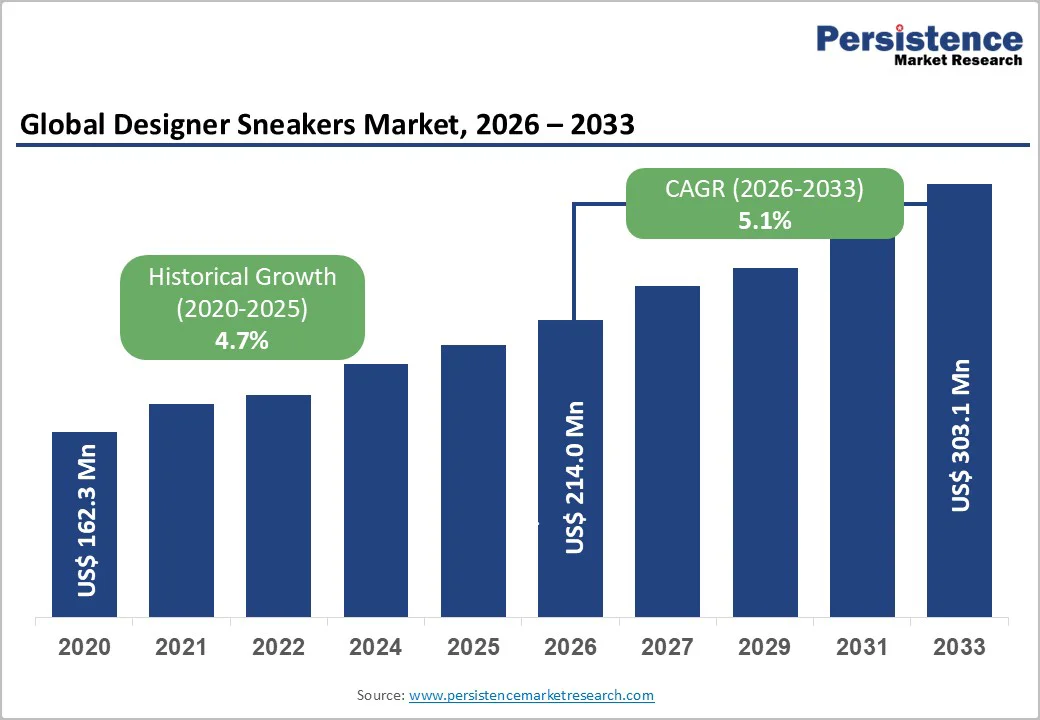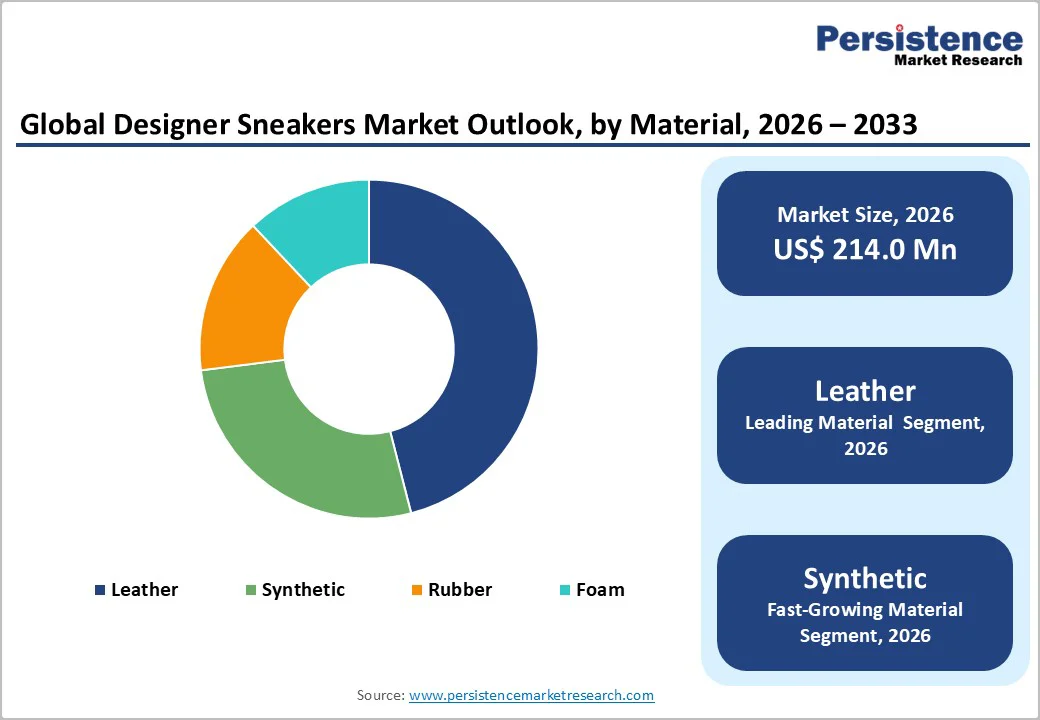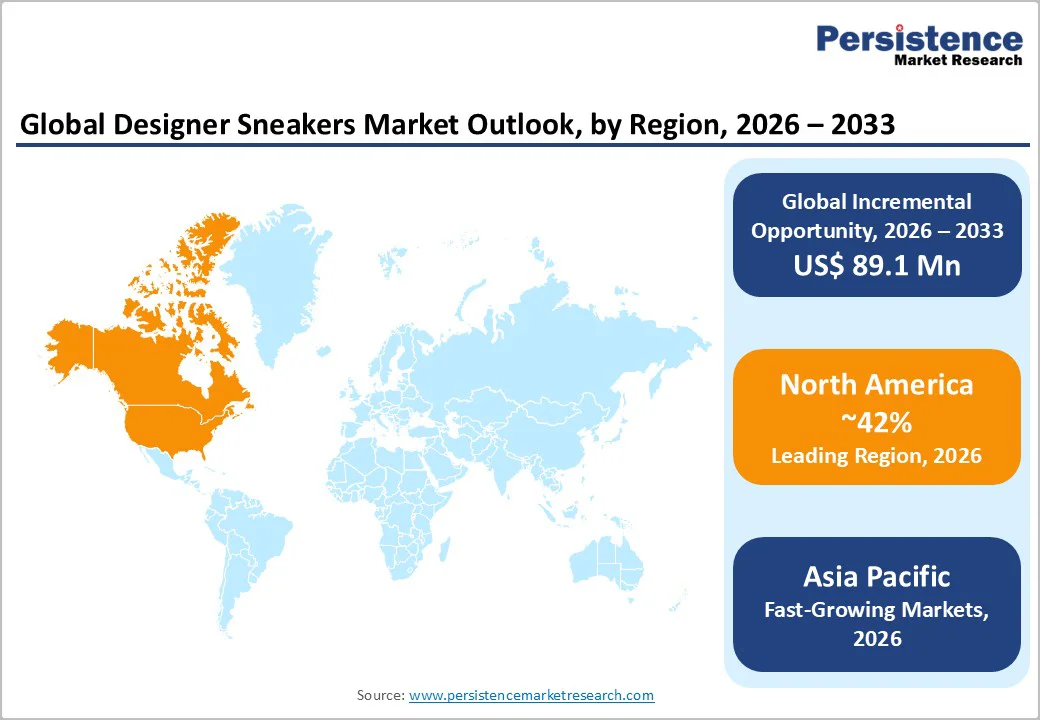ID: PMRREP34315| 198 Pages | 12 Dec 2025 | Format: PDF, Excel, PPT* | Consumer Goods

The global designer sneakers market size is likely to be valued at US$214.0 million in 2026 and is estimated to reach US$303.1 million by 2033, growing at a CAGR of 5.1% during the forecast period 2026 - 2033.
This robust growth path reflects rising demand for designer footwear, driven by shifting consumer preferences toward premium fashion sneakers, growing disposable incomes, and increasing digital and commercial penetration globally.
Market expansion is driven by strong growth in urbanization and athleisure trends, particularly among younger demographics, who embrace sneakers as a fashion statement. Supply-chain improvements and heightened adoption of online retail platforms further underpin the upward trajectory.
| Key Insights | Details |
|---|---|
| Designer Sneakers Market Size (2026E) | US$ 214.0 Mn |
| Market Value Forecast (2033F) | US$ 303.1 Mn |
| Projected Growth (CAGR 2026 to 2033) | 5.1% |
| Historical Market Growth (CAGR 2020 to 2025) | 4.7% |

Rising athleisure trends have significantly influenced consumer purchasing behavior, shifting preferences toward stylish yet comfortable footwear suitable for both casual and semi-formal settings. Sneakers have evolved from functional sportswear to lifestyle statements, blending performance features with luxury design.
Social media influence, celebrity endorsements, and the growing focus on wellness and active lifestyles have reinforced this cultural shift. Consumers increasingly perceive designer sneakers as versatile assets that complement modern wardrobes, driving demand across age groups and income segments.
Growing disposable income empowers consumers to invest in premium footwear that aligns with their personal style and status aspirations. As consumers have more financial flexibility, they are increasingly willing to explore high-end designs, limited-edition releases, and collaborations that reflect their individuality and lifestyle choices.
This financial capacity allows them to prioritize quality, exclusivity, and brand prestige over basic functionality, elevating the perceived value of premium sneakers. Over time, this willingness to spend on designer footwear contributes to broader market expansion, drives innovation in design and materials, and reinforces brand loyalty, supporting sustained growth in the premium sneaker segment.
Supply chain constraints and raw material volatility significantly impact production timelines and cost structures in the designer sneakers segment. Fluctuations in the prices of key materials, such as leather, synthetic fabrics, and rubber, lead to unpredictable manufacturing costs.
Global disruptions, including transportation bottlenecks and limited availability of specialized components, hinder the ability to maintain consistent inventory levels. These challenges have forced brands to either absorb increased costs or pass them to consumers, affecting profitability and demand elasticity.
Raw material volatility creates significant pressure on production costs, forcing manufacturers to adjust sourcing strategies or constantly explore alternative materials. Fluctuating prices of leather, synthetic fabrics, and rubber disrupt budget planning, while supply chain inefficiencies extend lead times and complicate inventory management.
Delays in transportation and limited availability of specialized components reduce responsiveness to consumer trends, affecting market competitiveness. These operational challenges constrain production scalability, restrict timely product launches, and increase the risk of margin erosion, ultimately limiting growth potential and strategic flexibility in the designer sneakers segment.
Sustainable innovation and customization stand out as major opportunities as brands face rising consumer expectations for environmentally responsible practices and distinctive product expression. Buyers increasingly evaluate footwear through the lens of material transparency, circular design principles, and reduced carbon impact.
Companies that integrate bio-based fabrics, recycled components, low-impact manufacturing, and traceable supply chains gain differentiation and pricing power. This shift aligns with the growing preference for responsible consumption, enabling brands to strengthen loyalty, command premium margins, and secure long-term relevance in a competitive landscape.
Personalization has moved from a value-added feature to a strategic growth lever. Consumers are seeking designs that reflect individual identity, lifestyle, and cultural influences, creating space for modular construction, 3D-knit uppers, color-swap options, and data-driven fit solutions.
Digital configurators and on-demand production enhance engagement while reducing inventory risks and waste. Firms that combine sustainability with tailored design deliver a compelling value proposition, positioning themselves to capture discerning customers who prioritize authenticity, creativity, and environmental stewardship.
Casual sneakers are projected to hold a commanding 58% market revenue share in 2026, driven by their versatility and alignment with the athleisure movement. Their broad appeal across demographics makes them a core daily-wear choice, encouraging repeat purchases and sustained consumer engagement.
Comfort, adaptability, and trend-driven designs enable brands to maintain high visibility and consistent sales. Retailers are leveraging collaborations, limited editions, and targeted marketing campaigns to reinforce loyalty. The combination of functionality and style positions casual sneakers as the clear leader in the global designer footwear market.
Formal sneakers are expected to grow strongly, reflecting a shift in consumer preferences toward hybrid, semi-formal footwear. Loosening professional dress codes and rising demand for stylish yet comfortable office-appropriate shoes are driving adoption in urban markets.
Evolving lifestyle trends and the appeal of elevated casual designs in corporate and social settings further support market expansion. Premium materials, exclusive collections, and designer collaborations are expected to stimulate consumer interest. As versatility becomes a key purchasing driver, formal sneakers are projected to gain significant traction between 2026 and 2033.
Leather sneakers are projected to hold a commanding 46% share of the designer sneakers market in 2026, driven by their premium durability, luxurious appeal, and strong brand association. Consumers increasingly view leather products as status symbols, reinforcing repeat purchases and loyalty.
Sustainable tanning practices and eco-conscious sourcing further enhance acceptance amid rising environmental awareness. High-quality finishes and timeless designs support consistent demand across demographics. Continued investment in craftsmanship, innovation, and heritage-focused storytelling ensures leather maintains its leadership position among designer sneakers.
Synthetic materials are forecasted to be the fastest-growing segment through 2033, propelled by their cost-efficiency, versatility, and rising vegan and eco-conscious preferences. Hybrid innovations that combine performance, comfort, and modern aesthetics appeal strongly to urban, style-conscious consumers.
Brands are leveraging synthetics to introduce experimental designs, limited editions, and sustainable collections, stimulating adoption. As buyers increasingly seek affordable, functional, and environmentally friendly alternatives, synthetic sneakers are projected to gain significant traction, making them a strategic focus for manufacturers and retailers.
Men are projected to hold a leading 56% revenue share in 2026, driven by their strong engagement with sneaker culture and sustained investment in sportswear. Social media influence and lifestyle trends amplify awareness and desire, reinforcing frequent purchases and brand loyalty.
Athletic-inspired designs, collaborations with high-profile influencers, and limited editions further enhance appeal across demographics. The combination of performance, style, and cultural relevance positions men’s sneakers as the dominant segment, capturing consistent consumer attention and reinforcing the prominence of male-focused product offerings.
Women consumers of designer sneakers are anticipated to surge the market forward during the 2026 - 2033 forecast period, as athleisure gathers momentum and the focus on style-oriented designs deepens. Rising urbanization, lifestyle-driven consumption, and demand for versatile footwear are driving adoption among female consumers.
Social media trends, influencer collaborations, and targeted campaigns amplify visibility and desirability. With increasing emphasis on comfort, aesthetics, and fashion-forward functionality, women’s sneakers are projected to gain substantial traction, establishing them as a strategic growth priority for brands seeking to capture evolving consumer preferences.

North America is projected to hold a commanding designer sneakers market share of approximately 42% in 2026, reflecting its strong sneaker culture and high consumer purchasing power. The region benefits from a mature retail ecosystem with flagship stores, experiential outlets, and integrated omnichannel solutions that enable seamless access to premium and limited-edition sneakers.
Urban culture, lifestyle trends, and digital influence drive sneaker adoption as a symbol of status and personal identity. Collaborations with athletes, musicians, and cultural icons enhance desirability and support repeated purchases. High per-capita spending on footwear indicates a consumer preference for innovation, exclusivity, and design quality, reinforcing dominance in premium segments.
Sophisticated e-commerce infrastructure contributes to North America’s leading position, supporting seamless online transactions and consumer engagement. Data-driven insights enable brands to anticipate trends, target specialized segments, and launch region-specific collections. Dense urban populations and highly active social media communities sustain interest and foster brand loyalty.
Experimental designs, limited editions, and lifestyle-focused campaigns maintain strong consumer attention and repeat purchases. These factors collectively create a self-reinforcing cycle of consumption, trend-setting, and brand dominance, securing North America’s position as the top region for designer sneakers in 2026.
Europe is projected to maintain a significant market presence in 2026, supported by heritage brands, fashion-forward consumer behavior, and strong retail networks. Major urban centers such as Paris, Milan, London, and Berlin serve as global style hubs, influencing trends and shaping consumer preferences.
Consumers in Europe prioritize craftsmanship, design aesthetics, and sustainability, driving demand for high-quality, premium sneakers. Flagship stores, multi-brand boutiques, and experiential retail contribute to visibility and reinforce brand prestige.
The region also demonstrates growing digital engagement, with e-commerce platforms expanding their reach and enabling targeted, data-driven campaigns. Collaborations with European designers, limited editions, and sustainability-focused launches resonate strongly with conscious consumers.
The combination of established brand loyalty, urban concentration, and trend-setting influence positions Europe as a key region for steady demand, innovation adoption, and premium positioning. While not growing as rapidly as the Asia Pacific, Europe remains strategically important for maintaining high-margin sales and reinforcing global brand image in the designer sneaker segment.
The Asia Pacific market is projected to experience the fastest growth from 2026 to 2033, driven by the massive scale and pace of urbanization, expanding disposable incomes, and a growing base of young, fashion-conscious consumers in India, China, and the ASEAN bloc. Increasing exposure to global lifestyle trends and the adoption of athleisure and hybrid sneaker styles are accelerating demand.
The region’s rapid digital adoption and e-commerce expansion enable brands to reach previously untapped urban and semi-urban markets. Social media influence and collaborations with local influencers further stimulate awareness and preference, encouraging frequent purchases and brand experimentation.
Emerging economies, primarily China and India, are experiencing a surge in consumption of premium and designer footwear. Urban centers with high population density create concentrated demand for exclusive designs and limited-edition releases.
Brands are leveraging regional insights to launch culturally resonant campaigns and tailored collections, strengthening engagement. The combination of rising consumer sophistication, digital accessibility, and lifestyle-driven adoption positions Asia Pacific as the primary growth engine, making it a strategic focus for global brands seeking expansion in the designer sneaker space.

The global designer sneakers market structure is moderately concentrated, with a handful of leading international brands capturing a significant portion of the market. These top players leverage strong brand heritage, design expertise, and extensive marketing capabilities to maintain dominance.
Their ability to introduce trend-setting collections, collaborate with high-profile influencers, and create limited-edition releases reinforces premium positioning and consumer loyalty. Despite this concentration, the segment remains open to competition due to the diversity of fashion preferences, regional tastes, and evolving lifestyle trends, which encourage experimentation and differentiation.
Fragmentation persists as smaller or regional brands, designer boutiques, and emerging labels capture niche demand. Estimates suggest that the top 10 players collectively control around 40% of the segment, leaving the remainder distributed among these specialized brands.
This structure enables ongoing innovation, localized design, and boutique experiences, providing opportunities for new entrants and regional players to gain traction alongside established global names.
The global designer sneakers market is projected to reach US$ 214.0 million in 2026.
Rising luxury fashion demand, celebrity influence, limited-edition drops, and growing athleisure trends are driving the market.
The market is poised to witness a CAGR of 5.1% from 2026 to 2033.
Increase in online luxury sales, incorporation of sustainable materials, and high demand for exclusive collaborations offer key market opportunities.
Some of the key market players include Nike, Adidas, Puma, Gucci, Louis Vuitton, and Balenciaga.
| Report Attribute | Details |
|---|---|
| Historical Data/Actuals | 2020 - 2025 |
| Forecast Period | 2026 - 2033 |
| Market Analysis | Value: US$ Mn |
| Geographical Coverage |
|
| Segmental Coverage |
|
| Competitive Analysis |
|
| Report Highlights |
|
By Product Type
By Material
By End-User
By Region
Delivery Timelines
For more information on this report and its delivery timelines please get in touch with our sales team.
About Author